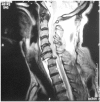Clinical Outcome in Patients with Early versus Delayed Decompression in Cervical Spine Trauma
- PMID: 25187859
- PMCID: PMC4149985
- DOI: 10.4184/asj.2014.8.4.427
Clinical Outcome in Patients with Early versus Delayed Decompression in Cervical Spine Trauma
Abstract
Study design: Prospective observational study.
Purpose: To assess the clinical outcome after early versus late decompression for traumatic cervical cord injury.
Overview of literature: Traumatic spinal cord injury is common globally with the most tragic outcomes in the cervical spine. Although recent studies have shown that early decompression results in more favourable outcome, its authority is yet to be established.
Methods: Study on 98 patients with a traumatic cervical cord injury was conducted over a period of 5 years. The patients who were operated on within 24 hours of the onset of the primary injury (n=34) were classified as the early group, and those who were operated on after 24 hours of the onset of the injury (n=64) were categorized as the late group. The outcome of both the groups was assessed using the American Spinal Injury Association (ASIA) Impairment Scale (AIS) at the 6-month follow-up.
Results: The patients in the early group were operated on at a mean time of 18.4 hours (range, 13-24 hours) while patients were operated on at a mean time of 52.7 hours (range, 31-124 hours) in the late group. At the 6-month follow-up, 7 (23.3%) in the early group and 5 (8.7%) in the late group showed >2 grade improvement in the AIS.
Conclusions: The results of patients undergoing decompression within 24 hours of the injury are better than those who are operated on later. An attempt should be made to decompress the traumatic cervical spine early in all possible cases.
Keywords: Spinal cord injuries; Spinal fixation; Spinal fractures; Surgical decompression; Treatment outcome.
Conflict of interest statement
No potential conflict of interest relevant to this article was reported.
Figures





References
-
- Wyndaele M, Wyndaele JJ. Incidence, prevalence and epidemiology of spinal cord injury: what learns a worldwide literature survey? Spinal Cord. 2006;44:523–529. - PubMed
-
- Korres DS. Injuries of the cervical spine. Athens: Litsas Medical Publications; 1993.
-
- Fehlings MG, Sekhon L. Cellular, ionic and biomolecular mechanisms of the injury process. In: Benzel EC, Tator CH, editors. Contemporary management of spinal cord injury: from impact to rehabilitation. Chicago: American Association of Neurologic Surgeons; 2005. pp. 33–50.
-
- Amar AP, Levy ML. Pathogenesis and pharmacological strategies for mitigating secondary damage in acute spinal cord injury. Neurosurgery. 1999;44:1027–1039. - PubMed
-
- Bracken MB, Holford TR. Effects of timing of methylprednisolone or naloxone administration on recovery of segmental and long-tract neurological function in NASCIS 2. J Neurosurg. 1993;79:500–507. - PubMed
LinkOut - more resources
Full Text Sources
Other Literature Sources
Research Materials

